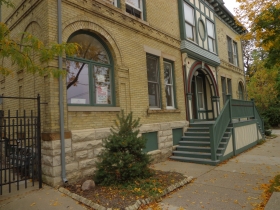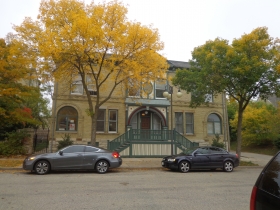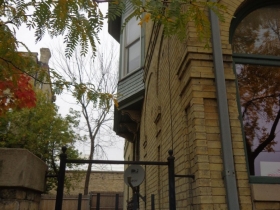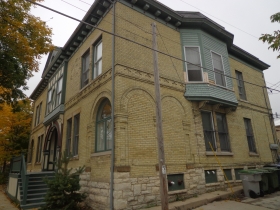Jonathan Jackson’s Very Urban Condo
The Milwaukee Film Festival leader lives in a converted, 1890 cream city building with a long history.
This is the first visit House Confidential to Brewers Hill, a neighborhood on the rise. Our honoree this week is Jonathan Jackson, the Executive Director of the Milwaukee Film Festival now underway.
He and his wife, Sara B. Mason Jackson, in whose name the property is titled, live in one of four condominium units housed in a charming 1890 Cream City brick building just off N. Martin Luther King, Jr. Drive.
It was originally a “brick cased” frame “double dwelling” designed by architect R. G. Kirsch for F. G. Winkler.
Kirsch designed a number of public buildings in Wisconsin, Missouri and Texas. His area projects included the Waukesha Court House, the Sheboygan and Port Washington jails and the City of Milwaukee morgue.

The exterior of our latest House Confidential honoree.
By 1939, the first floor of the building was remodeled into a two family unit, while the upper remained intact — briefly — as later that year the upstairs was converted into a two-family dwelling by owner Michael Sipusich. He lived in one unit and collected rents in three others.
In 1948 the building was part of what was known as the Milwaukee Defense Rental Area — as was nearly every residential rental property in Southeast Wisconsin. This was a wartime rent control program that kept rents at 1942 levels for the duration, and apparently then some. There were few opportunities to evict rent-paying tenants and then raise the rents for new tenants, but Sipusich tried one of them, saying he had to remove a family in the building so he could do “extensive carpentry” and varnishing. The administrators didn’t buy it, saying the tenant could remain while the work was done.
In 1951, Sipusich was back, this time asking the city for permission to turn the structure, (which had somehow grown to 7 units) into 8 apartments. These were 3 and 4 room units, and they must have contained miserably small rooms, since the whole building is just about 4,200 square feet.
There was a complicated transaction in 1956 when Sipusich tried to sell the building.
It was bought by a real estate agent, who then got a $15,000 mortgage. He gave the proceeds to Sipusich, along with the deed and an $11,000 promissory note. It was claimed to be a technique often used in a “downgrade neighborhood,” like that of Brewers Hill in the late 1950’s. Within a decade civil strife caused great property damage in the neighborhood during riots, and what was then N. 3rd St. struggled for its existence.
In 1988, with the city putting efforts into revitalizing the district — a process that continues to this day — Ken Duckert and partners applied to convert the jumble of apartments back into 4 units.
By 1997 the refreshed building held such tenants as Lansing M. Pope, who used his space for his home occupation of “visual design and repair.” In 2002, the building was once again remodeled and in 2003 it became a condominium.
The assessment on her property has declined every year, sadly, and is now $18,900 for the land, $86,000 for the improvements, for a total assessed valuation of $104,900. Taxes are $3,548.28, with a single installment of $275.43 remaining to be paid.
The Jackson family has grown with the recent birth of a child, and before long the one bedroom, one bath unit with combined dining room / living room might feel a bit cramped. Sure it is nice to have a dishwasher, and an in-unit laundry facility, to be bathed in the comforts of gas-fired forced air heat in the winter and be cooled by jets of centrally conditioned air in the summer, but one bedroom is kind of small.
The unit below is foreclosed and vacant, and available for a little over $100,000. Let’s hope that the market rises as steeply as Brewers Hill if the Jackson family chooses a new setting and needs to cash out.
There seems to be hope for this neighborhood that was once so vital, and then so “downgrade.” Brewers Hill is another excellent urban Milwaukee area close to downtown and ready to roll.
Photo Gallery
About Jonathan Jackson
Jonathan Jackson has said that he had never been in Milwaukee prior to beginning classes at UWM in 1998. But he is a hometown boy now, after running the UWM Union Theatre for a number of years before operating the Milwaukee International Film Festival from 2003 to 2008.
He has run the reorganized Milwaukee Film Festival since then.
Jackson also works in community arts outreach, and serves on the education committee of the Milwaukee Art Museum.
The film festival has been a huge success in the last few years, growing its audience and attracting significant grants from sponsors like Bud and Sue Selig and a number of others.
In 2011, the most recent year for which information is available, the group received grants of $1,722,533 in contributions and grants, and reaped $222,950 in “program revenue,” (i.e. ticket sales.)
Jackson, as executive director, received $76,561 in salary, a $20,000 raise from his first year there in 2008.
About the Milwaukee Film Festival
A Milwaukee film festival was organized in 2003 by Shepherd Express publisher Louis Fortis. He was able to persuade philanthropist Chris Abele and his Argosy Foundation, along with the Herzfeld Foundation, to provide financial support for the series. But in 2009 Abele decided he would not continue to fund it, citing concerns that the event was overly heavily advertised in Fortis’s Shepherd Express (and nowhere else), and that Fortis did not have an independent board to oversee the organization and its finances.
Abele then went on to re-form the group as the Milwaukee Film Festival, losing the “International” and any hope of future positive mention of the event (or himself) in the Shepherd Express, which can be depended on to run negative stories about Abele now that he serves as county executive. The Herzfeld Foundation switched its support to the new organization Abele formed, and new donors also began to fund the festival.
Fortis, meanwhile, sued Abele, and the suit went on for years, but went nowhere and in 2012 Fortis withdrew his complaint.
The Rundown
- Style: Cream City Confection with elements of corner tavern vernacular.
- Location: City of Milwaukee
- Neighborhood: Brewers Hill
- Walk Score: 80 out of 100. “Very Walkable.” Brewers Hill is the 19th most walkable neighborhood in the city of Milwaukee. Wolf Peach Restaurant is just .3 mile away.
- Street Smart Walk Score: 87 out of 100 “Very Walkable” Penny Saver Food Store is also just blocks away.
- Public Transit Score: 60 out of 100. “Good Transit” There are 15 bus lines nearby.
- Size: 1,065 square feet.
- Year Built: 1890, with the most recent remodeling and condo conversion in 2002-3.
- Assessed Value: Land — $18,900; Improvements — $86,000 Total $104,900
How Milwaukee Is It? Milwaukee City Hall is 1.23 miles south, and 75 feet downhill.
House Confidential Database
| Name | City | Assessment | Walk Score | Year |
|---|---|---|---|---|
| Name | City | Assessment | Walk Score | Year |

























Hi Michael: Two decades ago I rented (from the Duckert’s)…. the lower southwest facing unit for a few years, and loved it because I could walk to my studio in The Fortress Building.
I’ve always had such mixed feelings about Brewers Hill. Some of the homes and other buildings there are very nice and many have been very nicely renovated over the last 20 years or so. Plus, there’s been a fair amount of new construction as well. I’m not always totally impressed with new construction these days, but most of what’s been built in and near Brewers Hill does look pretty nice. Add to that some of the incredible views they get along that ridge overlooking the river and it could be a great area!
Yet, at the same time there’s just something unsettling about being in such close proximity of where the “thug zone” begins and the normal world ends. I’ve had numerous friends and acquaintances who’ve lived in Brewers Hill and have heard too many stories of coming out to your car in the morning and finding a smashed window or no car at all! Even worse, several robberies and burglaries, too. Yes, it could happen anywhere in the city, but the odds seem a lot higher in areas like Brewers Hill. That’s too bad!